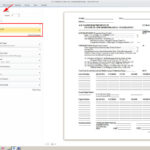In the realm of security and safety, vigilance and diligence are of paramount importance. Ensuring the security of a facility or a sensitive area is a multifaceted task, and one crucial aspect of this is conducting end-of-day security checks. These checks are essential to ensure that a facility is secure after regular operating hours. The process of conducting end-of-day security checks typically involves using specific forms designed for this purpose. In this article, we will explore the significance of end-of-day security checks and delve into the form used to record these checks.

Importance of End-of-Day Security Checks
End-of-day security checks are an integral part of maintaining the safety and security of a facility, whether it’s a commercial building, a government institution, or any other sensitive area. These checks serve several important purposes:
1. Preventing Unauthorized Access: One of the primary purposes of these checks is to ensure that no unauthorized individuals have gained access to the facility after hours. Unauthorized access can lead to theft, vandalism, or other security breaches.
2. Securing Sensitive Information: Many facilities house sensitive information or equipment that needs to be protected. End-of-day checks help ensure that confidential materials or valuable assets are properly secured.
3. Fire Safety: Checking for potential fire hazards, such as unattended equipment or electrical issues, is another crucial aspect of these checks. Early detection of fire risks can prevent disastrous incidents.
4. Property Protection: The end-of-day checks also help safeguard the property itself, ensuring that doors and windows are properly secured to prevent break-ins.
5. Emergency Preparedness: By conducting end-of-day checks, security personnel can verify that emergency exits are clear, fire extinguishers are in place, and other safety measures are functional, increasing overall preparedness for potential emergencies.
6. Peace of Mind: These checks provide peace of mind for facility managers and owners, knowing that they have taken steps to secure their assets and maintain the safety of their employees and visitors.
The End-of-Day Security Check Form
To effectively document and track end-of-day security checks, a specific form is often used. This form serves as a structured tool for security personnel to record their observations and actions taken during the check. The form’s design and content may vary, but the basic components typically include:
1. Date and Time: The form should start with spaces to record the date and time when the end-of-day security check is conducted. This timestamp is critical for tracking the frequency and consistency of the checks.
2. Name of the Person Conducting the Check: The name or identification of the security personnel responsible for the check is usually recorded. This helps in accountability and ensures that a specific individual is responsible for the check.
3. Facility Information: The form may have sections to include details about the facility, such as its name, location, and any unique identifiers.
4. Checklist Items: The core of the form is a checklist of items that need to be inspected during the end-of-day check. These items may include doors and windows, security systems, surveillance cameras, fire exits, emergency equipment, and more. Each item on the checklist should have a designated space for marking “checked” or “not checked.”
5. Comments and Observations: There is usually space on the form for security personnel to make comments or note any observations. This can include details about any issues encountered during the check, such as a malfunctioning security camera or a window left open.
6. Actions Taken: If any issues are identified during the check, there should be a section on the form for recording the actions taken to rectify the situation. For instance, if a door is found unlocked, the form should document whether it was locked and by whom.
7. Signature: After completing the end-of-day check, the security personnel must sign the form, confirming that the check was conducted, and the recorded information is accurate.
8. Supervisor’s Signature: In many cases, a supervisor or manager also signs the form, providing an additional layer of accountability and oversight.
It’s important to note that the specific form used may vary based on the organization, industry, or regulatory requirements. Some industries, such as government facilities or healthcare institutions, may have more stringent standards for their end-of-day security check forms.
Sample End-of-Day Security Check Form
For a more detailed understanding of what an end-of-day security check form may look like, we can refer to the sample form provided in the document from the Center for Development of Security Excellence (CDSE). The form includes the following elements:
1. Header Information: The form begins with the title “END OF DAY SECURITY CHECK FORM” and space to fill in the facility’s name, address, and phone number.
2. Instructions: There are clear instructions provided for completing the form, including noting the date and time of the check.
3. Checklist Items: The form includes a detailed checklist with items such as exterior doors, interior doors, windows, emergency exits, security systems, and more. Each item has space for marking “OK” or “Not OK.”
4. Comments/Deficiencies: A section is included for security personnel to note any comments or deficiencies. If an item is marked “Not OK,” this is where the issue is described.
5. Actions Taken: Security personnel can specify what actions they took to address any deficiencies. For example, if a window was found unlocked, they can note that it was secured.
6. Name and Signature: The form provides space for the name, signature, and date of the person conducting the check. Additionally, there is a space for a supervisor’s name and signature, adding an extra layer of validation.
7. Date/Time: The form concludes with a section for recording the date and time of the end-of-day security check.
This sample form is an excellent example of a structured and comprehensive tool for documenting end-of-day security checks. It ensures that security personnel follow a standardized process and provides a clear record of their activities and any issues encountered during the check.
Conclusion
End-of-day security checks play a critical role in safeguarding facilities, protecting assets, and ensuring the safety of personnel and visitors. The use of a well-designed form is essential in documenting these checks systematically and accurately. The form serves as a practical tool for security personnel to record their observations, actions taken, and any issues identified during the check. By maintaining a detailed record of end-of-day security checks, organizations can enhance their security measures, address vulnerabilities, and ensure a higher level of safety and protection for their premises.



